East Sand Island, a slim strip of sand, sludge, and beachgrass near the mouth of the Columbia River, is home to an estimated 28,000 cormorants. Make that 26,800 cormorants: Since Memorial Day, crews from the U.S. Department of Agriculture’s Wildlife Services have shot more than 1,200 adult birds and doused more than 5,000 nests with vegetable oil, suffocating developing cormorant chicks within their shells. By 2016, if all goes according to plan, the East Sand Island colony — the largest breeding colony of cormorants in North America — will have been shot and smothered down to less than half its current size.
No one is happy about said plan, but a lot of people think it’s necessary: Biologists estimate that the East Sand Island cormorants eat up to 20 percent of the young salmon and steelhead that pass through the river’s estuary. The U.S. Army Corps of Engineers, which operates the dams and locks on the Columbia and is required to protect the river’s endangered and threatened species, studied various ways of driving the cormorants out of the neighborhood, but concluded that the only way to reduce the population was to kill a lot of birds. The tribes that hold treaty rights to the river’s fish support the plan, but environmental groups point to a 2014 Fish and Wildlife Service analysis suggesting that young steelhead not eaten by cormorants would be eaten by something else. Five groups have sued to stop what is euphemistically described as the “cormorant cull,” calling it a distraction from the much larger threats to salmon posed by the river’s dams.
When I first heard about the cull, I assumed that it was both a uniquely local and uniquely modern dilemma — a painful collision between the Endangered Species Act and a bunch of hungry birds. But cormorants, it turns out, have been exasperating people in many places for many, many years.
There are some thirty species of cormorants around the world, six of them in North America. By far the most common North American species is the double-crested cormorant, which dominates the East Sand Island population. University of Minnesota biologists Linda Wires and Francesca Cuthbert, who have examined archaeological records and naturalists’ accounts for clues to past cormorant abundance, believe that before European settlement of the continent, double-crested cormorants were as widely distributed and at least as numerous as they are today.
In the late nineteenth and early twentieth centuries, however, cormorants gained a reputation as fish stealers, and were hunted for their feathers and for sport. (Their oily meat was sometimes used for fish bait, but rarely eaten.) North American cormorant numbers dropped more or less steadily until 1972, when DDT was banned and cormorants were protected under the Migratory Bird Treaty. Thanks to these conservation measures and to the species’ own tolerance for human-altered habitats, cormorants bounced back with alacrity — and the killing began again.
Biologist Richard King, author of The Devil’s Cormorant: A Natural History, writes that in 1998, a group of charter fishermen shot and stomped to death about 2,000 cormorants on Galloo Island in eastern Lake Ontario, in defiance of federal law. The group was prosecuted, but two years later, when a similar group in Michigan killed more than 500 cormorants, the law turned a blind eye. In the early 2000s, in response to continued nuisance complaints about the birds, the U.S. Fish and Wildlife Service loosened cormorant protections, allowing individuals and states to kill a total of 160,000 cormorants every year. The cormorant population on East Sand Island has ballooned by a hundredfold since 1989, partly because of legal and illegal eradication efforts elsewhere on the West Coast.
Cormorants have been culled energetically not only in North America but also in Japan, Australia, and Europe. In many of these cases, the birds are believed to be competing with local fishermen. Elsewhere, dense colonies have trampled island vegetation, causing serious erosion. But King, who has made something of a cultural study of cormorants, observes that cormorants inspire a loathing far out of proportion to the trouble they create. While gulls have multiplied alongside cormorants, and show a similar tolerance for human castoffs, people generally like them; pelicans have a comparable appetite for fish and their populations are growing, too, but they don’t draw the same resentment.
 Perhaps cormorants are just too obvious about their mischief: they hunt close to humans, and can gulp down ridiculously large fish (not to mention eels, frogs, and crabs). Or perhaps, King suggests, cormorants suffer some of the same ancient prejudices as other dark-feathered, croaky scavengers. Aristotle described cormorants as “water-ravens,” and “cormorous” was once a synonym for “ravenous.” The Bible associates cormorants with filth and death, and Milton, in Paradise Lost, describes Satan as sitting on the Tree of Life “like a cormorant.” While Jonathan Livingston Seagull gets to philosophize from great heights, Old Harry Cormorant sulks in the muck, embodying our worst impulses.
Perhaps cormorants are just too obvious about their mischief: they hunt close to humans, and can gulp down ridiculously large fish (not to mention eels, frogs, and crabs). Or perhaps, King suggests, cormorants suffer some of the same ancient prejudices as other dark-feathered, croaky scavengers. Aristotle described cormorants as “water-ravens,” and “cormorous” was once a synonym for “ravenous.” The Bible associates cormorants with filth and death, and Milton, in Paradise Lost, describes Satan as sitting on the Tree of Life “like a cormorant.” While Jonathan Livingston Seagull gets to philosophize from great heights, Old Harry Cormorant sulks in the muck, embodying our worst impulses.
Salmon populations in the Pacific Northwest are under enormous global, regional, and local pressures, and if the cormorants on East Sand Island are in fact one of those pressures, there may be good reason to shoot some of them. But it’s worth remembering that humans have borne a grudge against cormorants for centuries. We may not be over it yet.
Photo of Little Black Cormorants in Australia by Flickr user Chris Ring. Photo of cormorant eating an eel at a conservation center in France by Flickr user Tambako. Creative Commons.

Cormorants have a terrible PR problem! Their poop defoliates the trees they roost on until the islands they inhabit resemble bombed-out, post-apocalyptic moonscapes. They taste terrible, but eat a lot of the species of fish other folks care about. And, when startled, they either poop or barf before flying away – sometimes both.
I once got to visit a remote little island in Lake Michigan that was home to both nesting terns and cormorants. Upon our arrival, the terns rose up in mass and dive-bombed the intruders, trying to protect their young. The cormorants rose up and promptly abandoned their helpless fledglings to their fate, flying out a hundred or so yards from shore, where they sat waiting for us to leave! Whatever the opposite of “charismatic megafauna” is, cormorants are it!